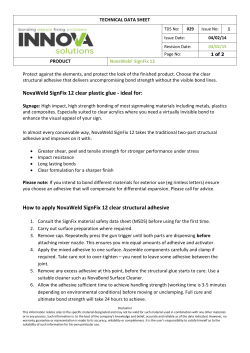
Pressure-sensitive adhesive technology enhances
Thought Leadership Pressure-sensitive adhesive technology enhances productivity in the value chain For major consumer goods companies, reducing downtime in operations is an ongoing goal. The next generation of adhesives allows brand owners to continue to improve productivity by mitigating operational issues caused by using pressure-sensitive label adhesives and maintaining adhesive performance during label application. Pressure-sensitive adhesives — the good and the bad Flexible, thin and conformable, pressure-sensitive (PS) labels offer some obvious benefits for brand owners in the application process. They can be applied using pressure, rather than glue or other substances, to refine the graphic quality of labels. Their unique performance and design properties also allow companies to conduct shorter production runs, change labels faster and reduce scrap in their processes. But despite all that PS labels allow big brands to accomplish, the adhesive technology that makes these labels advantageous can also cause problems during label application. These issues have the greatest impact for brands in operational costs and productivity. Technicians must interrupt production to stop and clean contaminated equipment or sort out contaminated products any time PSA problems occur. Furthermore, if PSA contamination is not immediately addressed, it can exacerbate operational problems even further by causing equipment malfunctions and additional inventory loss. All of this causes downtime, which makes label application less efficient and drives costs higher for brands. Inspired Brands. Intelligent World.™ label.averydennison.com Thought Leadership New adhesive technologies improve label application Fortunately, a new adhesive technology is allowing label developers to create PS labels that have all of the benefits of PS labels and mitigate the productivity pitfalls. Using a proprietary technology called ClearCut, label developer Avery Dennison recently introduced a group of PS labels that uses thinner films, liners and 25 percent less adhesive material. Because these labels are designed to deliver the same or better adhesion as those using thicker adhesives, they can reduce downtime for brand owners in a variety of ways. First, adhesives are a contaminant in a brand owner’s processes. By using a label with less adhesive material, companies have less adhesive material being applied to their bottles or containers, allowing them to reduce adhesive contamination by as much as 50 percent during label application and reapplication. Of course, many of the properties of a PS are also directly related to the adhesive, including its thickness and release properties. Therefore, improving the performance of adhesives also helps label developers improve the performance of PS labels. PS labels allow big brands to accomplish, the adhesive technology that makes these labels advantageous can also cause problems during label application. Improved productivity, with better or equal performance PS labels allow brand owners to apply labels faster, with broader options for design and performance than in the past. But the PSAs used in traditional labels are also a source of productivity pitfalls. By offering thinner films using less adhesive, label developers are helping brand owners reduce downtime, contamination and waste in their application processes. Not only can brands improve productivity without losing out on the adhesion, wet-out and design benefits that make pressure-sensitive labels desirable for packaging, but with more uptime and improved sustainability, they’ll be able to enjoy more efficiency in their operations. > For example, thinner PSA technology enables brands to use labels with thinner facestock and liners, as well. This gives them a PS label that has the same adhesive strength but a fraction of the weight — so they can get more labels on a roll. Improved open time and better repositionability, which allow technicians to easily rework misapplied labels, are also advantages that come with using thinner labels. These benefits help companies improve efficiency throughout the application process, whether it’s reducing shipping costs, inventory waste or downtime. © 2013 Avery Dennison Corporation. Avery Dennison brands, product names and codes are trademarks of the Avery Dennison Corporation. All other brands and product names are trademarks of their respective owners. Asia Pacific 32/F., Skyline Tower 39 Wang Kwong Road Kowloon Bay, Kowloon, Hong Kong +852 2802-9618 Europe Lammenschansweg 140 2321 JX Leiden The Netherlands +31 71/579-4100 Latin America Rodovia VinhedoViracopos, KM 77 CEP 13280-000 Vinhedo - SP, Brazil +55 19 3876-7600 North America 8080 Norton Parkway Mentor, OH 44060 440.534.6000
© Copyright 2025









